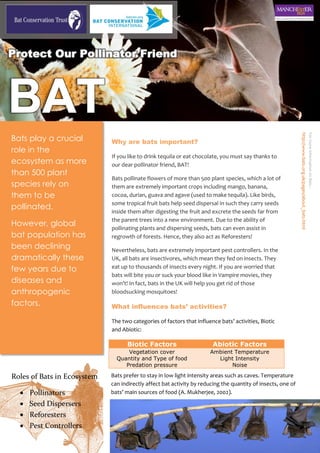
(9499338)BatFactSheet
- 1. Why are bats important? If you like to drink tequila or eat chocolate, you must say thanks to our dear pollinator friend, BAT! Bats pollinate flowers of more than 500 plant species, which a lot of them are extremely important crops including mango, banana, cocoa, durian, guava and agave (used to make tequila). Like birds, some tropical fruit bats help seed dispersal in such they carry seeds inside them after digesting the fruit and excrete the seeds far from the parent trees into a new environment. Due to the ability of pollinating plants and dispersing seeds, bats can even assist in regrowth of forests. Hence, they also act as Reforesters! Nevertheless, bats are extremely important pest controllers. In the UK, all bats are insectivores, which mean they fed on insects. They eat up to thousands of insects every night. If you are worried that bats will bite you or suck your blood like in Vampire movies, they won’t! In fact, bats in the UK will help you get rid of those bloodsucking mosquitoes! What influences bats’ activities? The two categories of factors that influence bats’ activities, Biotic and Abiotic: Biotic Factors Abiotic Factors Vegetation cover Quantity and Type of food Predation pressure Ambient Temperature Light Intensity Noise Bats play a crucial role in the ecosystem as more than 500 plant species rely on them to be pollinated. However, global bat population has been declining dramatically these few years due to diseases and anthropogenic factors. Roles of Bats in Ecosystem Pollinators Seed Dispersers Reforesters Pest Controllers FormoreinformationonBats: http://www.bats.org.uk/pages/about_bats.html Bats prefer to stay in low light intensity areas such as caves. Temperature can indirectly affect bat activity by reducing the quantity of insects, one of bats’ main sources of food (A. Mukherjee, 2002).
- 2. Threats to Bats: Deadly Fungus The global bats population have significantly dropped due to one of the biggest threats to bats – White Nose Syndrome disease (WNS) This fungus-caused disease has already wiped out massive population of bats in the North America. The parasitic fungus, Pseudogymnoascus destructans, invades the skin of hibernating bats and destroys their hydration and hibernation cycles causing them to awake during winter, burning up limited fat reserves and eventually die. It will take a long time for bats’ population to recover from this deadly disease since bats have a very low reproductive rate. Green Energy killing Bats? Despite it is encouraged to use green renewable energy, study from the University of Colorado Denver discovered that more than 600,000 bats were killed by wind energy turbines in 2012. “ I am not against wind energy. It’s clean, it reduces pollution and it creates jobs. But there are negative impacts. Still, I think this is a problem we can solve. ” Said Dr Hayes from UC Denver. How can you help bats? Join Bat Conservation Trust or any bat conservation association and volunteer in researches and bat conservation events! Scientists are trying to find out the reasons and causes behind the spreading of White Nose Syndrome and hopefully find a solution to stop the spreading in the near future. Figure below showed the map of current WNS (White Nose Syndrome) status. Bats have evolved in such they developed special tendons in their legs to allow them hang upside down without using energy to clinch their muscle, called tendon locking mechanism (TLM). When a bat finds a good spot to hang out and grabs on with its feet, the tendon pulls down and the saw-teeth in its tendons slide along the ribbings like ratchet, holding the feet clenched without wasting any energy from its muscle. Checkout Youtube video: Why Don't Sleeping Bats Fall Down? By SciShow For more information, Contact: Bat Helpline: 0345 1300 228 Bat Conservation Trust 5th floor, Quadrant House, 250 Kennington Lane, London SE11 5RD United Kingdom National Bat Monitoring Programme (NBMP) Philip Briggs Tel: 020 7820 7179 Email: nbmp@bats.org.uk Bat Conservation Trust The Bat Conservation Trust supports over 100 local bat groups and 5000 members and works with volunteers, scientists, industry and government both locally and nationally on a range of projects. To achieve our vision of a world where bats and people thrive together in harmony our work focuses on discovering more about bats and how they use the landscape, taking action to protect bats and enhance the landscapes on which they rely and inspiring people about bats and their environment, engaging them in their conservation.